Campbell Hausfeld Wire Feed Welder Dk671800av Parts List
 Loading...
Loading...
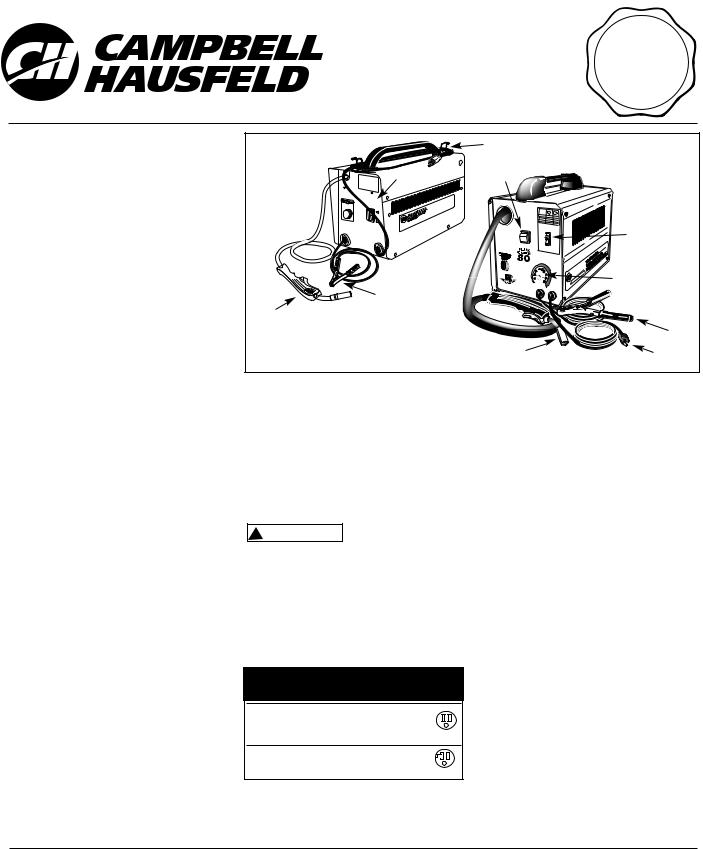
| Operating Instructions & Parts Manual | Models WF1800, WF1900 and WF2000 |
Please read and save these instructions. Read carefully before attempting to assemble, install, operate or maintain the product described. Protect yourself and others by observing all safety information. Failure to comply with instructions could result in personal injury and/or property damage! Retain instructions for future reference.
| RA | ||||||||||
| SU | NC | |||||||||
| S | E | P | ||||||||
| A | ||||||||||
| Y | R | |||||||||
| O | ||||||||||
| T | G | |||||||||
| AL | I | Need | R | |||||||
| A | ||||||||||
| U | Assistance? | M | ||||||||
| Q | ||||||||||
Call Us First!
1-800-746-5641
Description
The Campbell Hausfeld WF1800, WF1900 and WF2000 are 70 amp, single phase 115 volt input, wire feed arc welding machines. The WF2000 is equipped with infinite wire speed control to accurately select the proper wire feed rate needed for various welding conditions. Internal components are thermostatically protected.
This welding system is designed for use with the Flux Core Arc Welding (FCAW) process. As delivered from the factory, this welder can weld with .030" (.8 mm) or .035" (.9 mm) diameter flux-cored wire. A starter spool of wire is included.
POLARITY
Welders are configured for DCEN, direct current electrode negative.
DUTY CYCLE / THERMOSTATIC PROTECTION
Welder duty cycle is the percentage of actual weld time that can occur in a ten minute interval. For example, at a 10% duty cycle, actual welding can occur for one minute, then the welder must cool for nine minutes.
Internal components of this welder are protected from overheating with an automatic thermal switch. A yellow lamp is illuminated on the front panel (on/off switch) if the duty cycle is exceeded. Welding operations may continue when the yellow lamp is no longer illuminated.
MIG CONVERSION
The WF1800 and WF1900 are NOT convertible to MIG gas usage. Call 1-800- 746-5641 to purchase conversion kit (WT600400AJ) for WF2000.
Unpacking
All welding accessories for the welder are inside the wire feed compartment. Lift and/or remove
| 3 | ||||||||||||
| WF1800 | 4 | |||||||||||
| 4 | ||||||||||||
| WF2000 | ||||||||||||
| UTILITY | ||||||||||||
| WELDER | ||||||||||||
| Wire Feed | DELIVERS SMOOTH | Feed | Welder | en Fil | ||||||||
| Wire | ||||||||||||
| Welder | DC POWER | Alimente | e Continuo | |||||||||
| LOW | ||||||||||||
| OFF | Soudeur | Alambr | ||||||||||
| FLUX | con | |||||||||||
| CORE | HIGH | Soladar | ||||||||||
| WORK | ON | LOW | 6 | |||||||||
| CLAMP | ||||||||||||
| 115 VOLT | ||||||||||||
| 60HZ | OFF | |||||||||||
| HIGH | ||||||||||||
| CAMPBELL | ||||||||||||
| LAST | Y | |||||||||||
| HAUSFELDTO DUT | 5 | |||||||||||
| BUILT | ||||||||||||
| 10 | SERIOU | |||||||||||
| 1 | ||||||||||||
| 2 | ||||||||||||
| 1 | ||||||||||||
| 2 | 3 | |||||||||||
| Figure 1 - Welder Components and Controls | ||||||||||||
wire feed cover to find handle, workclamp, etc. When unpacking, inspect carefully for any damage that may have occurred during transit. Make sure any loose fittings and screws, etc. are tightened before putting unit into service.
Circuit Requirements
This equipment
! CAUTION requires a dedicated 115 volt circuit. Refer to the following chart for the correct circuit breaker or fuse rating. Do not run other appliances, lights, or tools on this circuit while operating this equipment. Extension cords are not recommended. Blown fuses and tripped circuit breakers can result from failure to comply with this recommendation.
| Heat | Circuit Breaker or |
| Selector | Slow Blow Fuse |
| Low | 15 amp |
| High | 20 amp |
See page 6 for supply cable replacement instructions.
Components and Controls
WF1800/WF1900
1. Work Clamp - connect to work piece.
2. Wire Feed Gun with .035" tip.
3. Power Cord - plug into 115 volt outlet.
4. Low/Off/High Switch - set according to metal thickness. Automatically controls wire speed. Lights if thermostat has automatically shut unit off.
WF2000
1. Work Clamp - connect to work piece.
2. Wire Feed Gun with .035" tip.
3. Power Cord - plug into 115 volt outlet.
4. On/Off Switch - lights if thermostat has automatically shut unit off.
5. Infinite Wire Speed Control - turn clockwise to increase wire speed and counterclockwise to decrease wire speed.
6. Heat Selector - Selects welding power. Two selections are possible; low and high.
| © 2002 Campbell Hausfeld/Scott Fetzer | For parts, product & service information | IN199006AV 3/02 |
visit www.chpower.com
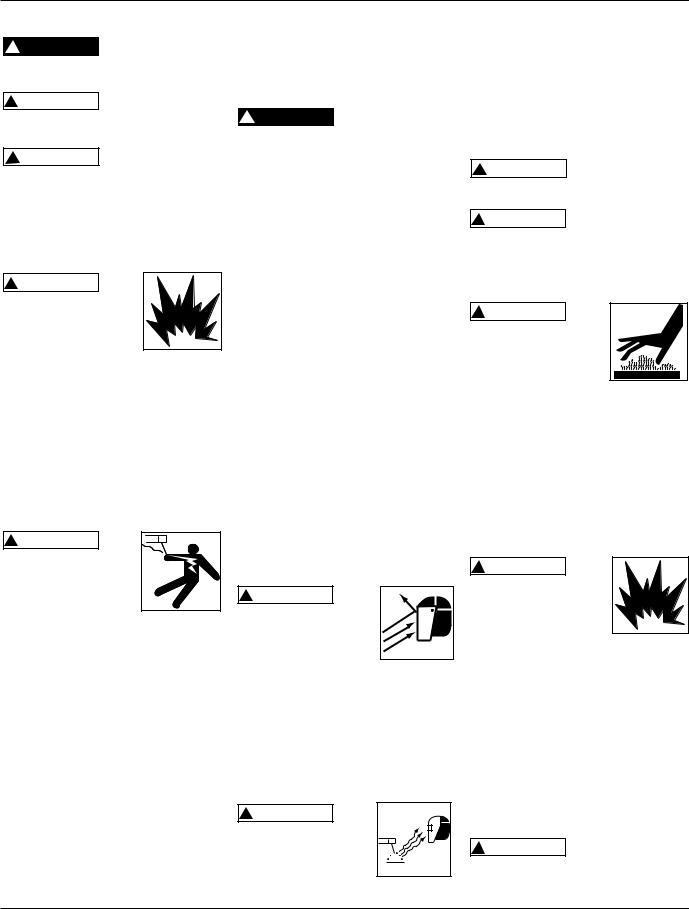
Operating Instructions and Parts Manual
General Safety
Danger means a ! DANGER hazard that will
cause death or serious injury if the warning is ignored.
Warning means a ! WARNING hazard that could
cause death or serious injury if the warning is ignored.
Caution means a ! CAUTION hazard that may
cause minor or moderate injury if the warning is ignored. It also may mean a hazard that will only cause damage to property.
NOTE: Note means any additional information pertaining to the product or its proper usage.
! WARNING
Always keep a fire extinguisher accessible while performing arc welding operations.
● Before starting or servicing any electric arc welder, read and understand all instructions. Failure to follow safety precautions or instructions can cause equipment damage and/or serious personal injury or death.
● All installation, maintenance, repair and operation of this equipment should be performed by qualified persons only in accordance with national, state, and local codes.
! WARNING
Improper use of electric arc welders can cause electric shock, injury, and death! Take all precautions described in
this manual to reduce the possibility of electric shock.
● Verify that all components of the arc welder are clean and in good condition prior to operating the welder. Be sure that the insulation on all cables, wire feed gun, and power cords is not damaged. Always repair or replace damaged components before operating the welder. Always keep welder panels, shields, etc. in place when operating the welder.
● Always wear dry, protective clothing and welding gloves, and insulated footwear.
● Always operate the welder in a clean, dry, well ventilated area. Do not operate the welder in humid, wet, rainy, or poorly ventilated areas.
● Be sure that the work piece is
properly supported and grounded prior to beginning any electric arc welding operation.
● Coiled welding cable should be spread out before use to avoid overheating and damage to insulation.
Never immerse the ! DANGER wire or wire feed
gun in water. If the welder becomes wet for any reason, be absolutely certain that it is completely clean and dry prior to attempting use!
● Always shut the equipment off and unplug the power prior to moving the unit.
● Always attach the work lead first.
● Verify that the work piece is securely grounded.
● Always shut off electric arc welding equipment when not in use and cut off any excess wire from the wire feed gun.
● Never allow any part of the body to touch the flux core wire and ground or grounded work piece at the same time.
● Awkward welding conditions and positions can be electrically hazardous. When crouching, kneeling or at elevations, be sure to insulate all conductive parts, wear appropriate protective clothing, and take precautions to prevent injury from falls.
● Never attempt to use this equipment at current settings or duty cycles higher than those specified on the equipment labels.
● Never use an electric arc welder to thaw frozen pipes.
! WARNING
Flying sparks and hot metal can cause injury. As welds cool, slag can be thrown off. Take all precautions described in
this manual to reduce the possibility of injury from flying sparks and hot metal.
● Wear ANSI approved face shield or safety glasses with side shield protection when chipping or grinding metal parts.
● Wear ear plugs when welding overhead to prevent spatter or slag from falling into ears.
! WARNING
Electric arc welding operations produce intense light and heat and ultraviolet (UV) rays. This
intense light and UV rays
can cause injury to eyes and skin. Take
all precautions described in this manual to reduce the possibility of injury to eyes and skin.
● All persons operating this equipment or in the area while equipment is in use must wear protective welding gear including: welding helmet or shield with at least shade 10 lens, flame resistant clothing, leather welding gloves, and full foot protection.
The welding wire is ! CAUTION live whenever the
welder is turned on - whether the trigger is pulled or not.
Never look at arc
! WARNING welding operations without eye protection as described above. Never use a shade filter lens that is cracked, broken, or rated below number 10. Warn others in the area not to look at the arc.
! WARNING
Electric arc welding operations cause sparks and heat metal to temperatures that can cause severe burns! Use
protective gloves and clothing when performing any metal working operation. Take all precautions described in this manual to reduce the possibility of skin and clothing burns.
● Make sure that all persons in the welding area are protected from heat, sparks, and ultraviolet rays. Use additional face shields and flame resistant barriers as needed.
● Never touch work pieces until completely cooled.
! WARNING
Heat and sparks produced during electric arc welding and other metal working operations can ignite flammable and explosive
materials! Take all precautions described in this manual to reduce the possibility of flames and explosions.
● Remove all flammable materials within 35 feet (10.7 meters) of welding arc. If removal is not possible, tightly cover flammable materials with fire proof covers.
● Do not operate any electric arc welder in areas where flammable or explosive vapors may be present.
● Take precautions to be sure that flying sparks and heat do not cause flames in hidden areas, cracks, etc.
Fire hazard! Do not ! WARNING weld on containers
or pipes that contain or have contained flammable materials or gaseous or liquid combustibles.
www.chpower.com
2
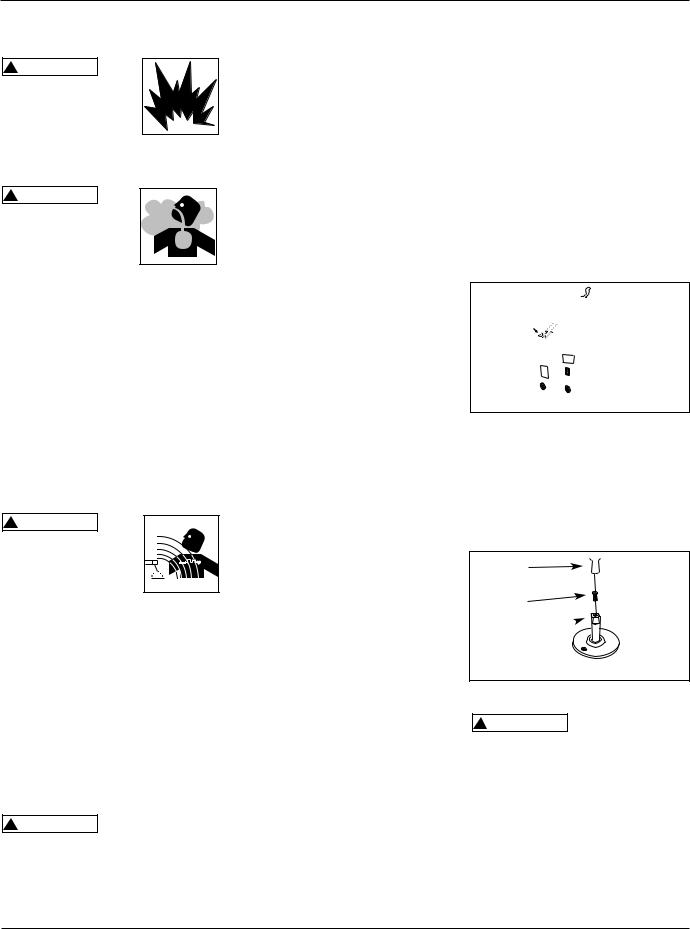
! WARNING
Models WF1800, WF1900 and WF2000
General Safety (Continued)
! WARNING Arc
welding closed cylinders or containers such as tanks or drums can cause explosion if not properly vented! Verify that any
cylinder or container to be welded has an adequate ventilation hole, so that expanding gases can be released.
! WARNING Do
not breathe fumes that are produced by the arc welding operation. These fumes are dangerous. If the welding area cannot
be adequately ventilated, be sure to use an air-supplied respirator.
● Keep the head and face out of the welding fumes.
● Do not perform electric arc welding operations on metals that are galvanized or cadmium plated, or contain zinc, mercury, or beryllium without completing the following precautions:
a. Remove the coating from the base metal.
b. Make sure that the welding area is well ventilated.
c. Use an air-supplied respirator.
Extremely toxic fumes are created when these metals are heated.
! WARNING The
electromagnetic field that is generated during arc welding may interfere with the operation of various electrical and
electronic devices such as cardiac pacemakers. Persons using such devices should consult with their physician prior to performing any electric arc welding operations.
● Route the wire gun and work cables together and secure with tape when possible.
● Never wrap arc welder cables around the body.
● Always position the wire gun and work leads so that they are on the same side of the body.
● Exposure to electromagnetic fields during welding may have other health effects which are not known.
Always be sure ! WARNING that the welding
area is secure and free of hazards (sparks, flames, glowing metal or slag) prior to leaving. Be sure that equipment is turned off and excess wire is cut off. Be sure that cables are loosely coiled and out of the way. Be sure that all metal and slag has cooled.
ADDITIONAL SAFETY STANDARDS
ANSI Standard Z49.1 from American Welding Society, 550 N.W. Le June Rd. Miami, FL 33126
Safety and Health Standards
OSHA 29 CFR 1910, from Superintendent of Documents, U.S. Government Printing Office, Washington, D.C. 20402
National Electrical Code
NFPA Standard 70, from National Fire Protection Association, Batterymarch Park, Quincy, MA 02269
Safe Handling of Compressed Gases in Cylinders
CGA Pamphlet P-1, from Compressed Gas Association, 1235 Jefferson Davis Highway, Suite 501, Arlington, VA 22202
Code for Safety in Welding and Cutting
CSA Standard W117.2, from Canadian Standards Association, Standards Sales, 178 Rexdale Boulevard, Rexdale, Ontario, Canada M9W 1R3
Cutting And Welding Processes
NFPA Standard 51B, from National Fire Protection Association, Batterymarch Park, Quincy, MA 02269
Safe Practices For Occupational And Educational Eye And Face Protection
ANSI Standard Z87.1, from American National Standards Institute, 1430 Broadway, New York, NY 10018
Refer to the Material Safety Data Sheets and the manufacturers instructions for metals, wire, coatings and cleaners.
Installation (All Models)
LOCATION
Selecting the proper location can significantly increase performance, reliability and life of the arc welder.
● For best results locate the welder in an environment that is clean and dry. Dust and dirt in the welder retain moisture and increase wear of moving parts.
● Place the welder in an area that provides at least twelve inches (305 mm) of ventilation space at both the front and rear of the unit. Keep all obstructions away from this ventilation space.
● Store flux core wire in a clean, dry location with low humidity to reduce oxidation.
● The receptacle used for the welder must be properly grounded and the welder must be the only load on the power supply circuit. Refer to the Circuit Amps chart on page 1 for correct circuit capacity.
● The use of an extension cord is not recommended for electric arc welding machines. The voltage drop in the extension cord may
significantly degrade the performance of the welder.
Assembly -
WF1800/WF1900
All welding accessories for the welder are inside the wire feed compartment. Lift wire feed cover to find handle, workclamp, etc.
Handle Assembly
1. Place handle assembly on welder, aligning two holes in the ends with threaded holes in welder housing.
2. Fasten screws through handle ends and into cabinet.
3. Insert cord storage clips into handle ends.


 Cord Storage
Cord Storage
Clip
Cord
Storage
Clip
UTILITY
WELDER
Figure 2 - Handle Assembly
Shaft Attachment
1. Open up the panel to expose the wire feed platform.
2. Align the shaft hole and notch to the welder screw hole and notch hole.
3. Fasten with screw down through the shaft and into the welder.
4. Press spring into top of spindle.
Spindle
Spring
Attachment
Screw
Spindle 

Figure 3 - Shaft Attachment Assembly
Flux Core Wire Installation
Welding power may be applied to
the output terminals, feed roll, work clamp, gun cable connection and welding wire even when the the gun switch is not activated. Do not touch these parts when the welding machine is on.
Note: Before installing welding wire, be sure that the diameter of the welding wire matches the groove in the drive roller on the wire feed mechanism and that the wire size matches the contact tip in the end of the gun (see Figure 5).
www.chpower.com
3
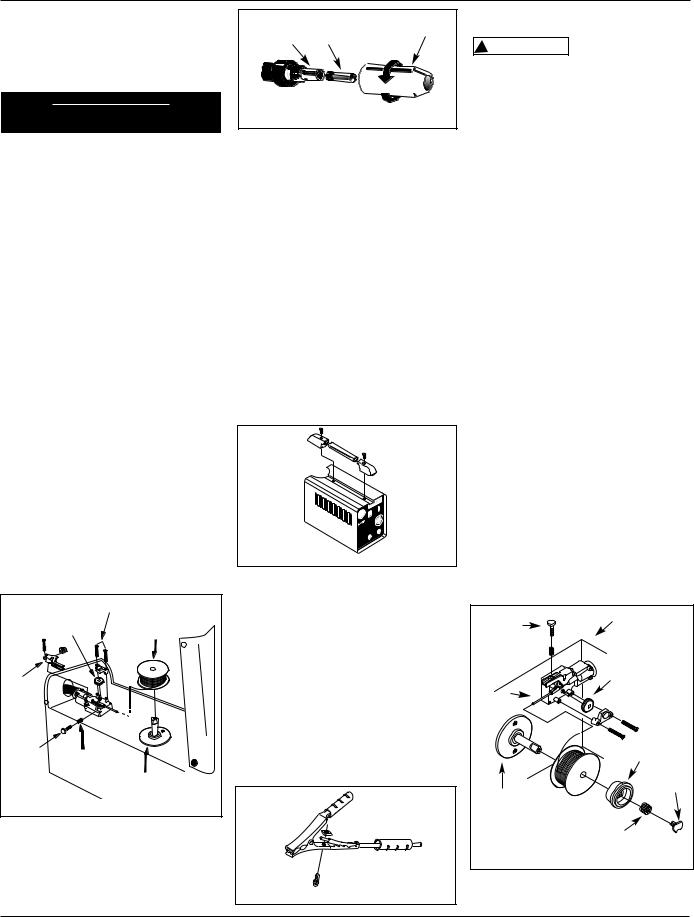
! WARNING
Operating Instructions and Parts Manual
Assembly - WF1800/
WF1900 (Continued)
Any mismatch could cause the wire to slip, bind or weld poorly.
Contact Tip Markings
| Mark | Wire Size | ||
| 0.8 | 0.030" | ||
| 0.9 | 0.035" | ||
| Wire Size Chart | |||
| Inches | mm | ||
| 0.030 | 0.8 | ||
| 0.035 | 0.9 | ||
1. Verify the unit is off and lift the panel on the welder to expose the wire feed mechanism.
2. Loosen the wire feed tensioning screw on the drive mechanism. This allows initial feeding of the wire into the gun liner by hand.
3. Install the wire spool onto the spindle so that the wire can come off the spool on the end closest to the wire feed guide tube. Do not cut the wire loose yet.
4. Hold the wire and cut the wire end from the spool. Do not allow the wire to unravel. Be sure that the end of the wire is straight and free of burrs.
5. Feed the wire through the wire feed guide tube, over the groove in the drive roll and into the gun liner. Tighten the wire feed tensioning screw so that it is snug. Do not over tighten. Close the wire feed panel.
| Pan Head Screws | ||
| Roller | Wire Flux | |
| Core | ||
| Swing | ||
| Arm | ||
| Tension | Tension | |
| Screw | ||
| Spring | ||
| Spindle | ||
| Figure 4 - Weld Wire Routing | ||
6. Remove the nozzle by turning counter-clockwise. Then unscrew the contact tip from the end of the welding torch (See Figure 5). Plug the welder into the proper power supply receptacle.
| Torch | Contact Tip | Nozzle |
| Diffuser | ||
| Figure 5 - Torch Nozzle | ||
7. Turn on the welder and activate the gun switch until the wire feeds out past the torch end. Turn welder off.
8. Carefully slip the contact tip over the wire and screw it into the torch end. Install the nozzle by turning clockwise. (See Figure 5). Cut the wire off approximately 1/4 inch from the end of the nozzle.
Assembly - WF2000
All welding accessories for the welder are inside the wire feed compartment. Lift and remove wire feed cover to find handle, workclamp, etc.
Handle Assembly
1. Slide handle into plastic ends as shown (Fig. 6).
Figure 6 - Handle Assembly
2. Place handle assembly on welder aligning two holes in plastic ends with threaded holes in welder housing.
3. Fasten screws through handle ends and into cabinet.
WORK CLAMP
1. Loosen hex bolt on work clamp.
2. Insert cord (labeled work on the front panel of the welder) through clamp handle and slide bare wire under the clamp block. Tighten hex bolt making sure bare wire is clamped securely (Fig. 7).
Figure 7 - Work Clamp Assembly
Flux Core Wire Installation
Welding power may be applied to
the output terminals, feed roll, work clamp, gun cable connection and welding wire even when the the gun switch is not activated. Do not touch these parts when the welding machine is on.
Note: Before installing welding wire, be sure that the diameter of the welding wire matches the groove in the drive roller on the wire feed mechanism and that the wire size matches the contact tip in the end of the gun (see Figure 5). Any mismatch could cause the wire to slip, bind or weld poorly.
| Wire Size Chart | ||||
| Inches | mm | |||
| 0.030 | 0.8 | |||
| 0.035 | 0.9 | |||
| Contact Tip Markings | ||||
| Mark | Wire Size | |||
| 0.8 | 0.030" | |||
| 0.9 | 0.035" | |||
1. Verify the unit is off and lift the panel on the welder to expose the wire feed mechanism.
2. Remove the spool quick lock by pushing in and rotating 1/4 turn counterclockwise. The knob, spring, and spool spacer can now be removed.
3. Loosen the wire feed tensioning screw on the drive mechanism. This allows initial feeding of the wire into the gun liner by hand.
| Tension | Panel |
| Screw | |
| Drive | |
| Guide | Roller |
| Tube | |
| Spool | |
| Spacer | |
| Spool | |
| Spindle | Lock |
| Spring | |
| Figure 8 - Weld Wire Routing | |
4. Install the wire spool onto the spindle so that the wire can come off
www.chpower.com
4
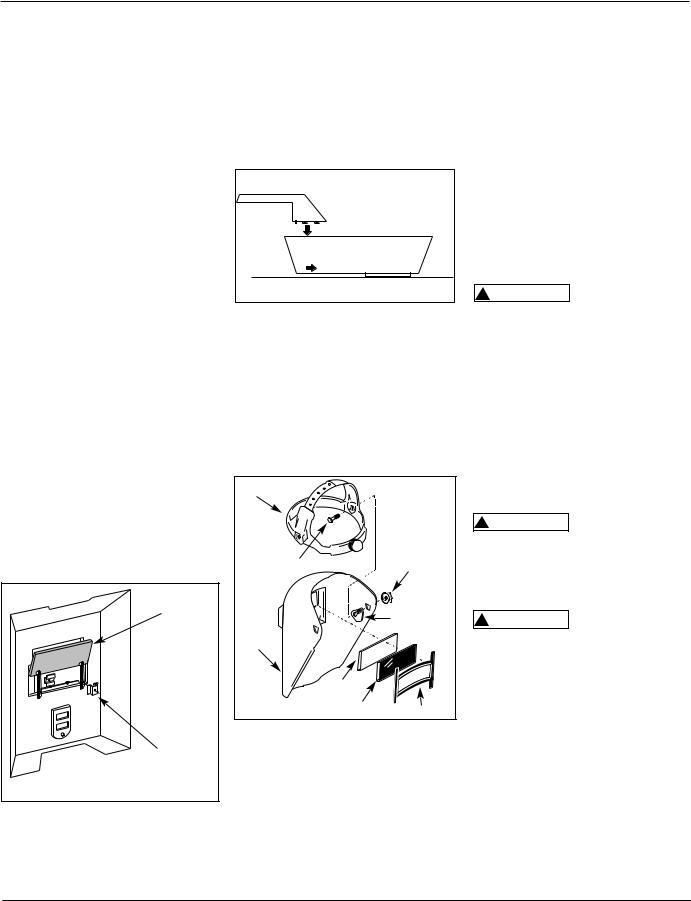
Models WF1800, WF1900 and WF2000
Assembly - WF2000
(Continued)
the spool on the end closest to the wire feed guide tube. Do not cut the wire loose yet. Install the spool spacer, spring, and quick lock knob by pushing in and turning the knob 1/4 rotation clockwise.
5. Hold the wire and cut the wire end from the spool. Do not allow the wire to unravel. Be sure that the end of the wire is straight and free of burrs.
6. Feed the wire through the wire feed guide tube, over the groove in the drive roll and into the gun liner. Tighten the wire feed tensioning screw so that it is snug. Do not over tighten. Install the outer welder panel.
7. Remove the nozzle by turning counter-clockwise. Then unscrew the contact tip from the end of the welding torch (See Figure 5). Plug the welder into the proper power supply receptacle.
8. Turn on the welder and set the wire speed rate to Maximum. Activate the gun switch until the wire feeds out past the torch end. Turn welder off.
9. Carefully slip the contact tip over the wire and screw it into the torch end. Install the nozzle by turning clockwise. (See Fig. 5). Cut the wire off approximately 1/4 inch from the end of the nozzle.
Handshield Assembly
WF1800
Lens
Lens
 Retainer
Retainer
Retainer
Stiffener
Figure 9 (WF2000 shown - WF1800 similar)
1. Cut retainer stiffeners away from shield. Trim the excess plastic to remove sharp edges.
2. Insert filter lens.
3. Attach the stiffeners over the pins on the lens retainers (See Figure 9).
WF2000
1. Cut retainer stiffeners and detachable handle away from shield. Trim the excess plastic to remove sharp edges.
2. Insert filter lens.
3. Attach the stiffeners over the pins on the lens retainers (See Figure 9).
4. To attach the handle, place shield on a flat surface and press handle into place (See Figure 10).
NOTE: If you have never welded before or have little experience, a full face helmet is recommended. Both hands are needed to stabilize and control the angle and arc length of the torch.
Welding Helmet
Assembly (Promotional
Models Only)
| Headgear | ||
| Tension | ||
| Stud Screw | Nut | |
| Adjustment | ||
| Face | Arm | |
| Shield | ||
| Clear Lens | ||
| Figure 11 | Shaded Lens | Lens Retainer |
1. Remove the lens retainer from the helmet.
2. Place the clear lens into the helmet first, then place the shaded lens into the helmet. The clear lens should be on the outside. Its purpose is the protect the shaded lens from sparks and spatter. Secure the two lenses by snapping the lens retainer in place.
3. Position the adjustment arm on the right side of the helmet. Place the small pin on the arm into one of the small holes in the helmet. This
adjustment controls the fit of the helmet when it is lowered, and can be easily repositioned if necessary.
4. Position the headgear inside the helmet. Assemble the helmet by inserting the stud screw through the headgear and helmet (and adjustment arm on the right side) into the tension nut as shown. Do not tighten the tension nut completely.
5. Trial fit the welding helmet. Adjust headgear ratchet band to a comfortable position and lower the helmet. If the helmet is too far or too close to the face, use a different hole for the adjustment arm. Adjust the tension nuts so the helmet can be easily lowered over the face by nodding the head.
Operation
The welding wire is ! CAUTION live whenever the
welder is turned on - whether the trigger is pulled or not.
1. Be sure to read, understand, and comply with all precautions in the General Safety Information section. Be sure to read the entire section entitled Welding Guidelines prior to using this equipment.
2. Turn welder off.
3. Verify that the surfaces of metals to be joined are free from dirt, rust, paint, oil, scale or other contaminants. These contaminants make welding difficult and cause poor welds.
All persons
! WARNING operating this equipment or in the area while equipment is in use must wear protective welding gear including: eye protection with proper shade, flame resistant clothing, leather welding gloves, and full foot protection.
If heating,
! WARNING welding, or cutting materials that are galvanized, zinc plated, lead, or cadmium plated refer to the General Safety Information Section for instructions. Extremely toxic fumes are created when these metals are heated.
4. Connect the work clamp to the work piece or workbench (if metal). Make sure the contact is secure. Avoid surfaces with paint, varnish, corrosion, or non-metallic materials.
5. Position the Heat Selector on the front panel to the desired setting.
NOTE: These settings are general guidelines only. Heat setting may vary according to welding conditions and materials.
www.chpower.com
5
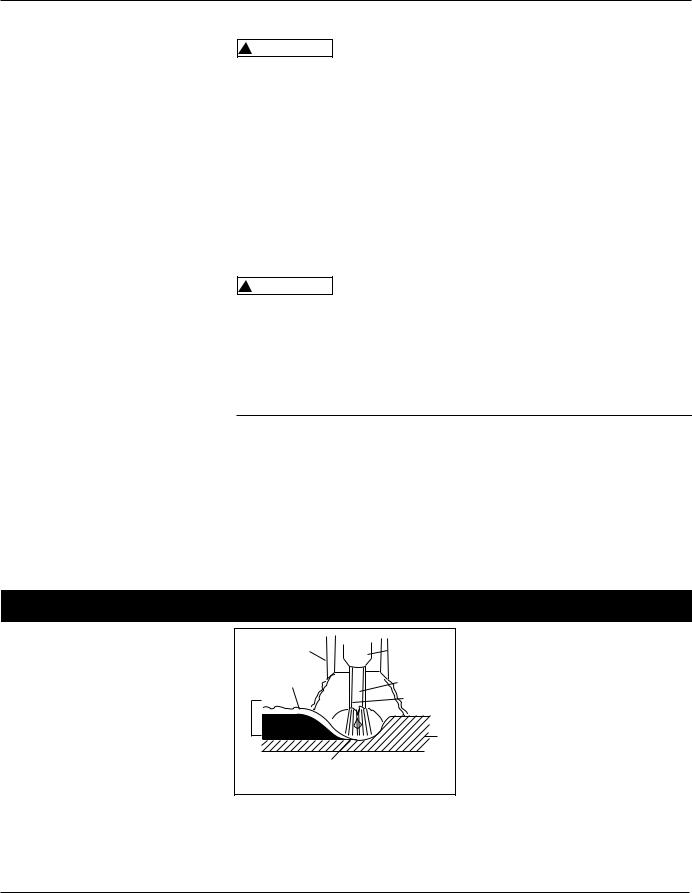
Operating Instructions and Parts Manual
Operation (Continued)
| Metal | Heat | ||
| Thickness | Setting | ||
| 14 - 18 Gauge | Low | ||
| Thicker Than 14 Gauge | High | ||
6. Rotate the Wire Speed Control to setting number 5 to start with, then adjust as needed after test weld. The WF1800's wire speed is automatically adjusted to the heat selection chosen.
7. Plug the input cord into a proper voltage receptacle with proper circuit capacity (See circuit requirements on front page).
8. Switch the welder ON/OFF switch to the ON position. For the WF1800/WF1900, switch the welder to the desired heat setting.
9. Verify that the wire is extended 1/4" from the contact tip. If not, squeeze the trigger to feed additional wire, release the trigger, and cut wire to proper length.
10. Position the wire feed gun near the work piece, lower the welding helmet by nodding the head, or position the hand shield, and squeeze the gun trigger. Adjust heat setting and wire speed as needed. Wire speed is not adjustable on the WF1800.
11. When finished welding, turn welder off and store properly.
Maintenance
Disconnect power ! WARNING supply and turn
machine off before inspecting or servicing any components. Keep the wire compartment cover closed at all times unless the wire needs to be changed.
Before every use:
1. Check condition of weld cables and immediately repair or replace any cables with damaged insulation.
2. Check condition of power cord and immediately repair or replace any cord if damaged.
3. Inspect the condition of the gun tip and nozzle. Remove any weld slag. Replace gun tip or nozzle if damaged.
Do not operate this ! WARNING welding machine
with cracked or missing insulation on welding cables, wire feed gun, or power cord.
Every 3 months:
1. Replace any unreadable safety labels on the welder.
2. Use compressed air to blow all dust and lint from the ventilation openings.
3. Clean the wire groove on the drive roll. Remove wire from the feed mechanism, remove screws from the drive roll housing. Use a small wire brush to clean the drive roll. Replace if worn or damaged
Consumable and Wear Parts
The following parts require routine maintenance:
• Wire feed drive roller
• Gun liner - replace if worn
• Nozzle/contact tips
• Wire - The WF2000 will accept either 4" or 8" diameter spools. The WF1800/WF1900 will accept 4" spools only. Flux-cored welding wire is susceptible to moisture and oxidizes over time, so it is important to select a spool size that will be used within approximately 6 months. Use AWS type E71T-GS or E71T-11, .030" (.8mm) or .035" (.9mm) diameter.
Supply Cable Replacement
1. Verify that welder is OFF and power cord disconnected.
2. Remove welder cover to expose the ON/OFF switch.
3. Disconnect the black and white power cord wires connected to the ON/OFF switch.
4. Disconnect the green power cord wire connected to welder frame.
5. Loosen the cord strain relief screw(s) and pull cord out of strain relief.
6. Install new cord in reverse order.
Welding Guidelines
General
This line of welding machines utilizes a process called Flux Cored Arc Welding (FCAW). The FCAW process uses a tubular wire with a flux material inside. Shielding is obtained from the decomposition of the flux within the tubular wire.
When current is produced by a transformer (welding machine) and flows through the circuit to the weld wire, an arc is formed between the end of the weld wire and the work piece. This arc melts the wire and the work piece. The melted metal of the weld wire flows into the molten crater and forms a bond with the work piece as shown in Figure 12.
| Diffuser | Contact | |
| Nozzle | Tip | |
| Slag | Flux | |
| Weld | Wire | |
| Crater | Work Piece | |
| Figure 12 - Weld Components | ||
Arc Welding Basics
Five basic techniques affect weld quality. These are: wire selection, heat setting, weld angle, wire speed, and travel speed.
An understanding of these techniques is necessary for effective welds.
HEAT SETTING
The correct heat involves the adjustment of the welding machine to
the required setting. Heat or voltage is regulated by a switch on the welder. The heat setting used depends on the size (diameter) and type of wire, position of the weld, and the thickness of the work piece.
Consult specifications listed on the welder or generalized chart in the Operation section. It is suggested that the welder practice with scrap metal to adjust settings, and compare welds with Figure 17.
www.chpower.com
6

Travel angle is the angle in the line of welding and may vary from 5º to 45º from the vertical, depending on welding conditions.
Work angle is the angle from horizontal, measured at right angles to the line of welding. For most applications, a 45º travel angle and 45º work angle is sufficient. For specific applications, consult an arc welding handbook.
WIRE SPEED - WF2000
The wire speed is controlled by the knob on the front panel. The speed needs to be "tuned" to the rate at which the wire is being melted in the arc. Tuning is one of the most critical functions in wire feed welding. Tuning should be performed on a scrap piece of metal the same type and thickness as that to be welded. Begin welding with one hand "dragging" the gun nozzle across the scrap piece while adjusting the wire speed with the other hand. Too slow of speed will cause sputtering and the wire will burn up into the contact tip (See Figure 17). Too fast a speed will also cause a sputtering sound and the wire will push into the plate before melting. A smooth buzzing sound indicates the wire speed is properly tuned. Repeat the tuning procedure each time there is a change in heat setting, wire diameter or type, or work piece material type or thickness.
TRAVEL SPEED
The travel speed is the rate at which the wire is moved across the weld area. Factors such as diameter and type of weld wire, amperage, position, and work piece material thickness all effect the speed of travel necessary for completing a good weld (See Fig. 17). When the speed is too fast, the bead is narrow and bead ripples are pointed as shown. When the speed is too slow, the weld metal piles up and the bead is high and wide.
SLAG REMOVAL
Wear ANSI
! WARNING approved safety glasses (ANSI Standard Z87.1) and protective clothing when removing slag. Hot, flying debris can cause personal injury to anyone in the area.
After completing the weld, wait for the welded sections to cool. A protective coating called slag now covers the weld
7
Welding Guidelines (Continued)
WIRE TYPE AND SIZE
The correct choice of wire type involves a variety of factors, such as welding position, work piece material type, thickness, and condition of surface to be welded. The American Welding Society, AWS, has set up certain requirements for each type of wire.
The AWS classification for self-shielding wire (FCAW process) is a multi digit number preceded by the letter E.
E - 7 0 T - GS
 Weld strength, times 10,000 pounds per square inch Welding positions (0
Weld strength, times 10,000 pounds per square inch Welding positions (0
for flat or horizontal, 1 for any position) Tubular flux core wire Flux type
AWS E71T-GS or E71T-11 is recommended for these welders.
WELD ANGLE
Weld angle is the angle at which the diffuser nozzle is held during the welding process. Using the correct angle ensures proper penetration and bead formation. As different welding positions and weld joints become necessary, nozzle angle becomes an increasingly important factor in obtaining a satisfactory weld. Weld angle involves two positions - travel angle and work angle.
5º - 45º
Work Angle
5º - 45º
Travel Angle
Figure 13 - Weld Angle
Models WF1800, WF1900 and WF2000
bead which prevents contaminants in the air from reacting with the molten metal. Once the weld cools to the point that it is no longer glowing red, the slag can be removed. Removal is done with a chipping hammer. Lightly tap the slag with the hammer and break it loose from the weld bead. The final clean-up is done with a wire brush. When making multiple weld passes, remove the slag before each pass.
WELDING POSITIONS
Four basic welding positions can be used; flat, horizontal, vertical, and overhead. Welding in the flat position is easier than any of the others because welding speed can be increased, the molten metal has less tendency to run, better penetration can be achieved, and the work is less fatiguing. Welding is performed with the wire at a 45º travel angle and 45º work angle.
Other positions require different techniques such as a weaving pass, circular pass, and jogging. A higher skill level is required to complete these welds.
Overhead welding is the least desirable position as it is the most difficult and dangerous. Heat setting and wire selection will vary depending upon the position.
All work should be performed in the flat position if possible. For specific applications, consult an arc welding technical manual.
WELD PASSES
Sometimes more then one pass is necessary to fill the joint. The root pass is first, followed by filler passes and the cover pass (See Fig. 14). If the pieces are thick, it may be necessary to bevel the edges that are joined at a 60º angle. Remember to remove the slag before each pass.
Cover 

Filler 
Root 
Figure 14 - Fillet Welds (60˚ Bevel)
www.chpower.com
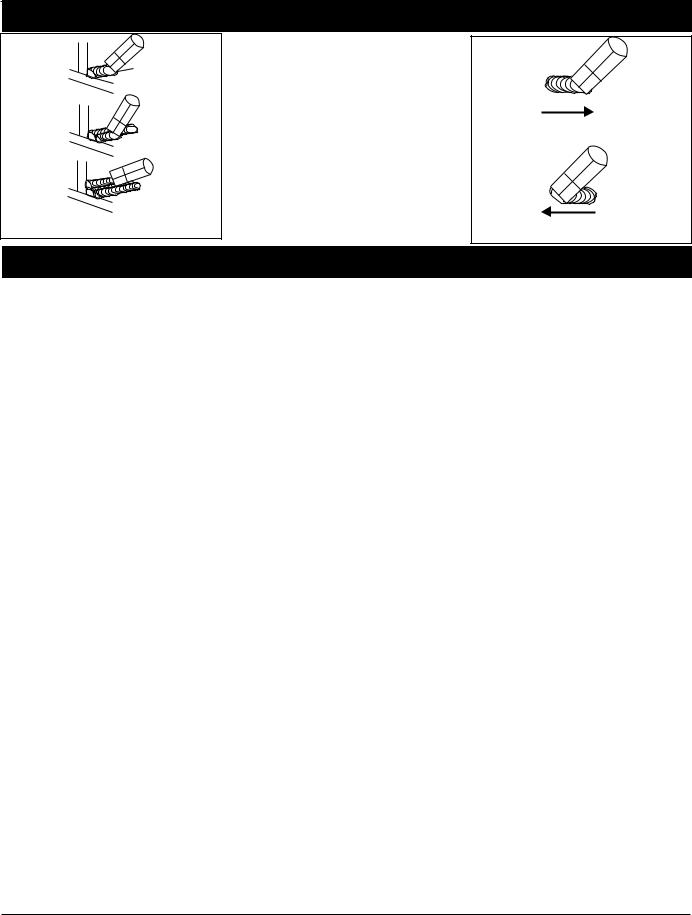
Operating Instructions and Parts Manual
Welding Guidelines (Continued)
PUSH VS PULL TECHNIQUE
The type and thickness of the work piece dictate which way to point the gun nozzle. For thin materials (18 gauge and up), the nozzle should point out in front of the weld puddle and push the puddle across the workpiece. For thicker steel, the nozzle should point into the puddle to increase weld penetration. This is called backhand or pull technique (See Figure 16).
Figure 15 - Multiple Weld Passes
Glossary of Welding Terms
AC or Alternating Current - electric current that reverses direction periodically. Sixty cycle current travels in both directions sixty times per second. Arc Length - the distance from the end of the electrode to the point where the arc makes contact with the work surface. Base Metal - the material to be welded. Butt Joint - a joint between two members aligned approximately in the same plane.
Crater - a pool, or pocket, that is formed as the arc comes in contact with the base metal.
DC or Direct Current - electric current which flows only in one direction. The polarity (+ or -) determines which direction the current is flowing.
DC Reverse Polarity - occurs when the electrode holder is connected to the positive pole of the welding machine. Reverse Polarity directs more heat into melting the electrode rather than the work piece. It is used on thinner material.
DC Straight Polarity - occurs when the electrode holder is connected to the negative pole of the welding machine. With straight polarity more heat is directed to the work piece for better penetration on thicker material. Electrode - a coated metal wire having approximately the same composition as the material being welded.
Fillet Weld - approximately a triangle in cross-section, joining two surfaces at right angles to each other in a lap, T or corner joint.
Flux - a coating, when heated, that produces a shielding gas around the welding area. This gas protects the parent and filler metals from impurities in the air.
Flux Cored Arc Welding (FCAW) - also called Gasless, is a welding process used
with a wire-feed welding machine. The weld wire is tubular with flux material contained inside for shielding.
Gas Metal Arc Welding (GMAW) - also called MIG, is a welding process used with a wire feed welding machine. The wire is solid and an inert gas is used for shielding.
Gas Tungsten Arc Welding (GTAW) - also called TIG, is a welding process used with welding equipment with a high frequency generator. The arc is created between a non-consumable tungsten electrode and the work piece. Filler metal may or may not be used.
Lap Joint - a joint between two overlapping members in parallel planes.
Open Circuit Voltage (OCV) - the voltage between the electrode and the work clamp of the welding machine when no current is flowing (not welding). The OCV determines how quickly the arc is struck.
Overlap - occurs when the amperage is set too low. In this instance, the molten metal falls from the electrode without actually fusing into the base metal. Porosity - gas pockets, or cavities, formed during weld solidification. They weaken the weld.
Penetration - the depth into the work piece that has been heat effected by the arc during the welding process. A good weld achieves 100% penetration meaning that the entire thickness of the work piece has been heated and resolidified. The heat effected area should be easily seen on the opposite side of the weld.
Shielded Metal Arc Welding (SMAW)
- also called Stick, is a welding process that uses a consumable electrode to support the arc. Shielding is achieved by
the melting of the flux coating on the electrode.
Slag - a layer of flux soot that protects the weld from oxides and other contaminants while the weld is solidifying (cooling). Slag should be removed after weld has cooled. Spatter - metal particles thrown from the weld which cool and harden on the work surface. Spatter can be minimized by using a spatter resistant spray on the work piece before welding.
Tack Weld - weld made to hold parts in proper alignment until final welds are made.
Travel Angle - the angle of the electrode in the line of welding. It varies from 5º to 45º depending on welding conditions.
T Joint - made by placing the edge of one piece of metal on the surface of the other piece at approximately a 90º angle. Undercut - a condition that results when welding amperage is too high. The excessive amperage leaves a groove in the base metal along both sides of the bead which reduces the strength of the weld.
Weld Pool or Puddle - a volume of molten metal in a weld prior to its solidification as weld metal.
Weld Bead - a narrow layer or layers of metal deposited on the base metal as the electrode melts. Weld bead width is typically twice the diameter of the electrode.
Work Angle - the angle of the electrode from horizontal, measured at right angles to the line of welding.
www.chpower.com
8
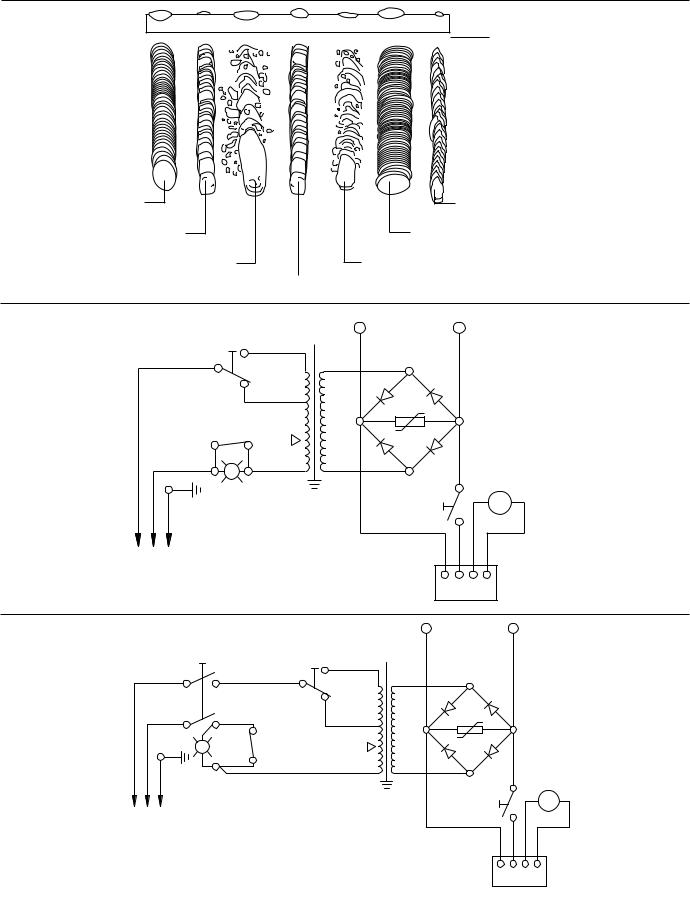
Models WF1800, WF1900 and WF2000
Base metal
| Normal heat, wire speed, | Travel speed too fast |
| travel speed | |
| Heat too low | Travel speed too low |
| Heat too high | Wire speed too slow |
| Figure 17 - Weld Appearance | Wire speed too fast |
| + TO WORK CLAMP | - TO TORCH | ||
| S1 | MIN | T1 | |
| OFF | ~ | ||
| MAX | |||
| S3 NC | + | - | |
| OPENS @ 120˚C | S3 | ||
| Y | ~ | ||
| DRIVE DECK | |||
| GROUND | S2 | - M + | |
| GUN | |||
WIRE SPEED
4 3 2 1 CONTROL BOARD
Figure 18 - Wiring Schematic (WF1800)
| + TO WORK CLAMP | - TO TORCH | |||
| ON/OFF | ||||
| S1 | S2 | T1 | ||
| MIN | ||||
| 1 | 2 | ~ | ||
| MAX | ||||
| 4 | ||||
| 5 | + | - | ||
| Y | S4 NC | S4 | ||
| OPENS @ 127∞C | ||||
| 6 | ||||
| GROUND | ~ | DRIVE | ||
| DECK | ||||
| S3 | - | M | + | ||
| L2 | L1 | GUN | |||
4 3 2 1
| Figure 19 - Wiring Schematic (WF2000) | WIRE SPEED | |
| CONTROL BOARD | ||
www.chpower.com
9
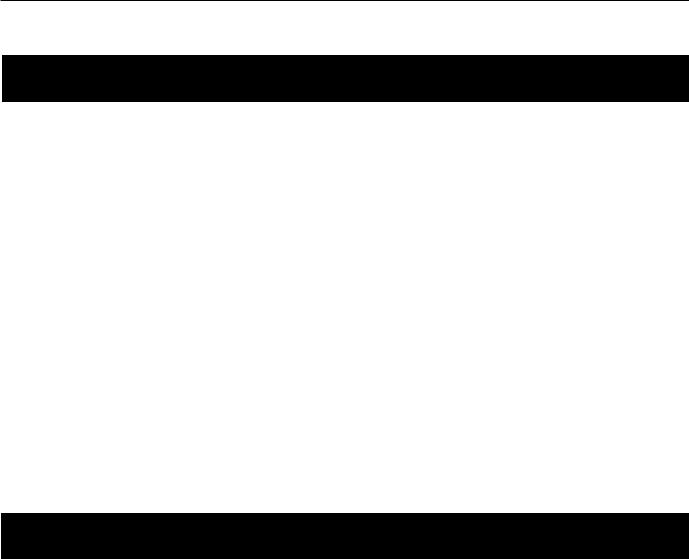
Operating Instructions and Parts Manual
For Information About This Product Call 1-800-746-5641
Troubleshooting Chart - Welder
| Symptom | Possible Cause(s) | Corrective Action |
| No output | 1. Duty cycle exceeded | 1. Allow welder to cool until ON/OFF Switch lamp goes out |
| 2. Poor work clamp | 2. Be sure all connections are secure, and attaching surface is | |
| connection | clean | |
| 3. Defective ON/OFF | 3. Replace switch | |
| switch | ||
| 4. Blown breaker or fuse | 4. Reduce circuit load, reset breaker or replace fuse | |
| Wire tangles at drive roller | 1. Wrong size gun tip | 1. Use proper size gun tip |
| 2. Gun liner clogged or | 2. Clean or replace gun liner | |
| damaged | ||
| 3. Gun tip clogged or | 3. Clean or replace gun tip | |
| damaged | ||
| 4. Feed roller worn | 4. Replace | |
| 5. Not enough tension | 5. Tighten tensioning screw | |
| Gun nozzle arcs to work surface | Slag inside gun nozzle | Clean slag from gun nozzle |
| Work clamp and/or cable gets | Poor contact | Be sure all connections are secure, and attaching surface is |
| hot | clean | |
| Wire does not feed | 1. Wire jammed | 1. Reload wire |
| 2. Out of wire | 2. Replace wire spool | |
| 3. Not enough tension | 3. Tighten tensioning screws if wire is slipping | |
| 4. Wire liner worn | 4. Replace liner |
Troubleshooting Chart - Welds
| Symptom | Possible Cause(s) | Corrective Action | ||
| Bead is intermittently too thin | 1. Inconsistent travel speed | 1. Decrease and maintain constant travel speed | ||
| 2. Output heat setting too low | 2. Increase output heat setting | |||
| Bead is intermittently too thick | 1. Slow and/or inconsistent | 1. Increase and maintain travel speed | ||
| travel speed | ||||
| 2. Output heat setting too high | 2. Reduce output heat setting | |||
| Ragged depressions at edge of | 1. Travel speed too fast | 1. Decrease travel speed | ||
| weld | 2. Wire speed too fast | 2. Decrease wire speed (WF2000) | ||
| 3. Output heat setting too high | 3. Reduce output heat setting | |||
| Weld bead does not penetrate | 1. Inconsistent travel speed | 1. Decrease and maintain constant travel speed | ||
| base metal | 2. Output heat setting too low | 2. Increase output heat setting | ||
| 3. Excessive extension cord length | 3. Use an extension cord no longer than 20 ft. | |||
| Wire sputters and sticks | 1. Damp wire | 1. Use dry wire and store in dry location | ||
| 2. Wire speed too fast | 2. Reduce wire speed | |||
| 3. Wrong type of wire | 3. Use flux core wire only (Do not use MIG or copper | |||
| color wire) | ||||
| www.chpower.com |
10
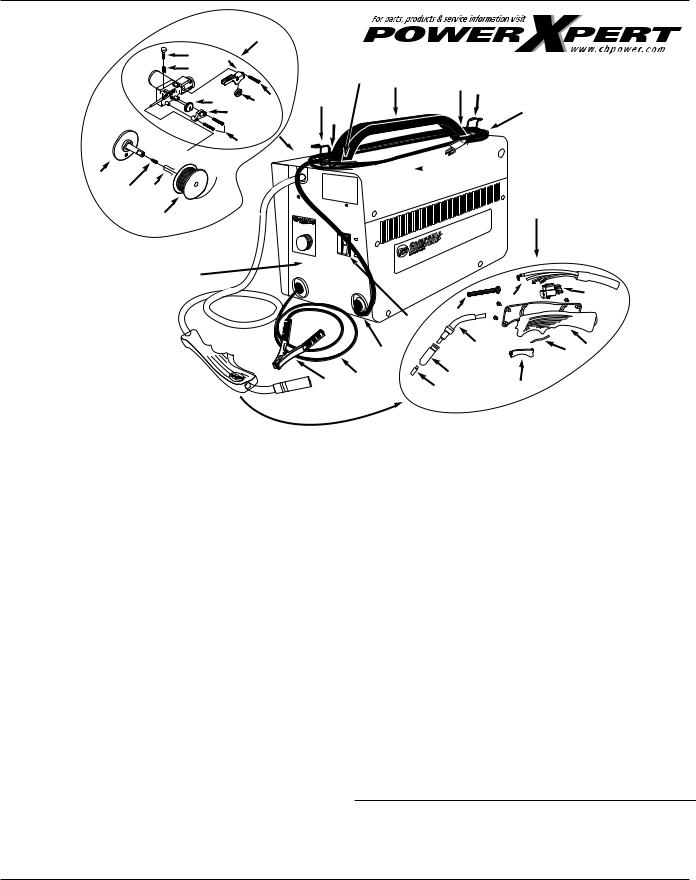
Models WF1800 & WF1900
| 17 | |||||
| 19 | 23 | ||||
| 18 | |||||
| 20 | 22 | ||||
| 21 | 24 | ||||
| 22 | |||||
| 13 | 16 | ||||
| 14 | |||||
| 15 | |||||
| For Information | 34 | ||||
| Inside | |||||
| About | |||||
| This Product | |||||
| Call 1-800-746-5641 | |||||
| 27 | 25 | 27 | |
| 30 | |||
30
12
11
Inside
 28
28
| UTILITY | 1 | |||||||||||||
| WELDER | ||||||||||||||
| Wire | Feed | DELIVERS | SMOOTH | e Feed | Welder | en | Fil | |||||||
| DC | ||||||||||||||
| Welder | POWER | Wir | Alimente | e Continuo | ||||||||||
| LOW | ||||||||||||||
| OFF | Soudeur | Alambr | ||||||||||||
| FLUX | Soladar | con | ||||||||||||
| CORE | ||||||||||||||
| HIGH | ||||||||||||||
| WORK | CLAMP | |||||||||||||
| 115 | VOLT | 32 | ||||||||||||
| 60HZ | 29 | |||||||||||||
| 33 | ||||||||||||||
| 10 | ||||||||||||||
| 26 | 31 | 7 | 2 | |||||||||||
| 8 | 9 | 4 | 6 | |||||||||||
| 5 | ||||||||||||||
Figure 20 - Models WF1800 & WF1900
| Replacement Parts | |||||
| Ref. | |||||
| No. | Description | Part Number | Qty | ||
| 1 | Torch assembly and hose | WC600900AJ | 1 | ||
| 2 | Torch body, front and back | WC600201AV | 1 | ||
| 3 | ▲ Hanger clip | WC600003AV | 1 | ||
| 4 | Nozzle | WT502100AV | 1 | ||
| 5 | Contact tip - 0.035" (0.9 mm) | WT501400AV | 1 | ||
| Optional contact tip - 0.030" (0.8 mm) | |||||
| (4-pack) | WT501300AJ | † | |||
| Optional contact tip - 0.035" (0.9 mm) | |||||
| (4-pack) | WT501400AJ | † | |||
| 6 | Trigger | WC600202AV | 1 | ||
| 7 | Torch contact spring | WC600203AV | 1 | ||
| 8 | Work clamp (Cord not included) | WC100300AV | 1 | ||
| 9 | Welding cable 8 AWG (6 ft) | 1 | |||
| 10 | High/Off/Low switch | WC401000AV | 1 | ||
| 11 | Safety decal (left) | DK670000AV | 1 | ||
| 12 | Power cord 14-3 AWG (6 ft) type SJT | 1 | |||
| 13 | Spindle | WC500700AV | 1 | ||
| 14 | M4.8-1.6 x 16 mm Sheet metal screw | 1 | |||
| 15 | Optional flux-core wire .030" | ||||
| (0.8 mm), 2 lb. | WE200001AV | † | |||
| Optional flux-core wire .035" | |||||
| (0.9 mm), 2 lb. | WE200501AV | † | |||
| 16 | Spindle spring | WC500701AV | 1 | ||
| 17 | Drive deck assembly | ||||
| (Includes Nos. 18 - 24) | WC500000AV | 1 | |||
| 18 | Tension spring | WC500003AV | 1 | ||
| 19 | Tension screw | WC500002AV | 1 | ||
| Ref. | ||||
| No. | Description | Part Number | Qty | |
| 20 | Roller, .6-.9mm | WC500001AV | 1 | |
| 21 | Roller cover | WC500004AV | 1 | |
| 22 | M4.2-1.4 x 35 mm Sheet metal screw | 3 | ||
| 23 | Swing arm | WC500005AV | 1 | |
| 24 | Swing arm roller | WC500007AV | 1 | |
| 25 | Handle | WC301300AV | 1 | |
| 26 | Strain relief | WC102000AV | 2 | |
| 27 | M4.2-1.4 x 10 mm Sheet metal screw | 2 | ||
| 28 | Safety decal (right) | DK670001AV | 1 | |
| 29 | Liner, coated metal | WC600208AV | 1 | |
| 30 | Cord storage clip | WC301301AV | 2 | |
| 31 | Swan neck w/diffuser | WC600701AV | 1 | |
| 32 | Valve body | WC600204AV | 1 | |
| 33 | Trumpet liner | WC600305AV | 1 | |
| 34 | ▲ Wire speed control board (inside) | WC401600AV | 1 | |
| 35 | ▲ Welding helmet (WF1900 only) | WT100000AV | 1 | |
| 36 | ▲ Replacement lens kit - one shaded | |||
| and two clear | WT110501AV | † | ||
| 37 | ▲ Handshield (lens not included) | |||
| (WF1800 only) | WC801200AV | 1 | ||
| 38 | ▲ Shaded lens (for handshield) | WC801100AV | 1 | |
| 39 | ▲ Chipping hammer/brush | WC803000AV | 1 | |
▲ Not Shown
† Optional accessory, sold separately
Standard hardware item, available at local hardware or welder supply store
www.chpower.com
11
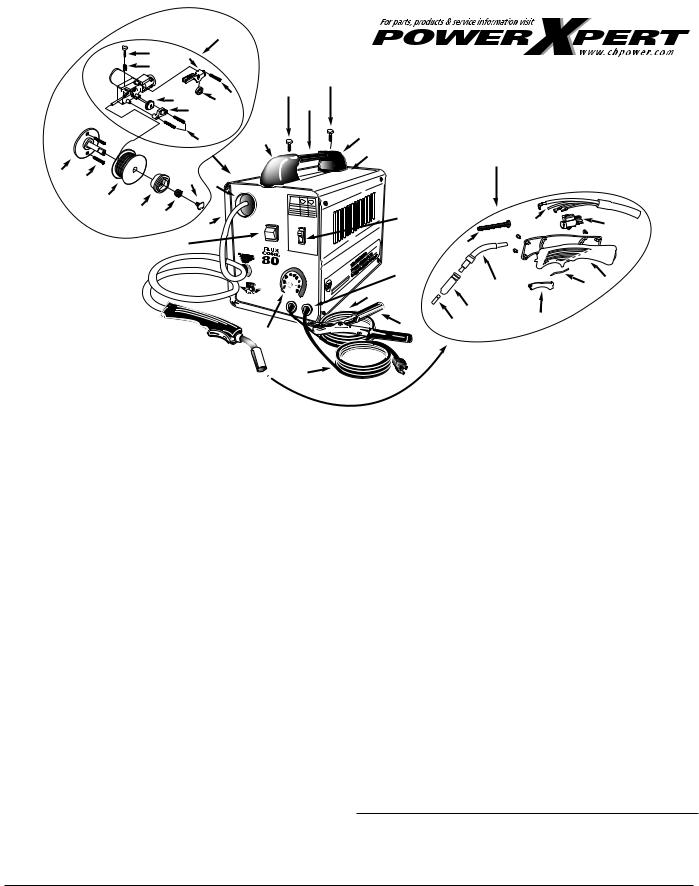
| Operating Instructions and Parts Manual | Model WF2000 |
| 23 | ||||||||
| 25 | 30 | |||||||
| 24 | ||||||||
| 26 | 29 | 28 | 33 | |||||
| 15 | ||||||||
| 27 | ||||||||
| 28 | 34 | |||||||
| Inside | ||||||||
| 17 | 18 | 22 | 39 | |||||
| 19 | ||||||||
| 20 | 21 | |||||||
| 31 | ON | |||||||
| LOW | ||||||||
| 13 | OFF | H | IGH | |||||
| CH | ||||||||
| 10 | ||||||||
| 10, 11 | ||||||||
| 33 | For Information About | ||
| This Product | |||
| 34 | Call 1-800-746-5641 | ||
| 14 | 1 | ||
| 12 | 35 | 37 | |||
| 38 | |||||
| CAMPBELL | 32 | 2 | |||
| HAUSFELDTO DUTY | 36 | 7 | |||
| BUILT | |||||
| LAST | |||||
| SERIOUS | 9 | ||||
| Figure 21 - Model WF2000 | 16 | ||||||
| Replacement Parts | |||||||
| Ref. | |||||||
| No. | Description | Part Number | Qty | ||||
| 1 | Torch assembly and hose | WC600900AJ | 1 | ||||
| 2 | Torch body, front and back | WC600201AV | 1 | ||||
| 3 | Hanger clip | WC600003AV | 1 | ||||
| 4 | Nozzle | WT502100AV | 1 | ||||
| 5 | Contact tip - 0.035" (0.9 mm) | WT501400AV | 1 | ||||
| Optional contact tip - 0.030" (0.8 mm) | |||||||
| (4-pack) | WT501300AJ | † | |||||
| Optional contact tip - 0.035" (0.9 mm) | |||||||
| (4-pack) | WT501400AJ | † | |||||
| 6 | Trigger | WC600202AV | 1 | ||||
| 7 | Torch contact spring | WC600203AV | 1 | ||||
| 8 | Work clamp (Cord not included) | WC100300AV | 1 | ||||
| 9 | Welding cable 8 AWG (6 ft) | 1 | |||||
| 10 | Wire speed knob | WC400201AV | 1 | ||||
| 11 | Wire speed control board (inside) | WC402100AV | 1 | ||||
| 12 | Low/high switch | WC400300AV | 1 | ||||
| 13 | On/off switch | WC400000AV | 1 | ||||
| 14 | Safety decal | DK670100AV | 1 | ||||
| 15 | Handle | WC300100AV | 1 | ||||
| 16 | Power cord 14-3 AWG (6 ft) Type SJT | 1 | |||||
| 17 | Spool spindle | WC500300AV | 1 | ||||
| 18 | M4.8-1.6 x 10 mm Sheet | ||||||
| metal screw | 2 | ||||||
| 19 | Optional flux-core wire .030" (0.8 mm) | ||||||
| 2 lbs. | WE200001AV | † | |||||
| 10 lbs. | WE201000AV | † | |||||
| Optional flux-core wire .035" (0.9 mm) | |||||||
| 2 lbs. | WE200501AV | † | |||||
| 10 lbs. | WE201500AV | † | |||||
| Ref. | ||||
| No. | Description | Part Number | Qty | |
| 20 | Spool adapter | WC500200AV | 1 | |
| 21 | Spool spring | WC500101AV | 1 | |
| 22 | Spool locking hub | WC500100AV | 1 | |
| 23 | Drive deck assembly | |||
| (Includes Nos.24 - 30) | WC500000AV | 1 | ||
| 24 | Tension spring | WC500003AV | 1 | |
| 25 | Tension screw | WC500002AV | 1 | |
| 26 | Roller, .6 - .9mm | WC500001AV | 1 | |
| 27 | Roller cover | WC500004AV | 1 | |
| 28 | M4.2-1.4 x 35 mm Sheet | |||
| metal screw | 3 | |||
| 29 | Swing arm roller | WC500007AV | 1 | |
| 30 | Swing arm | WC500005AV | 1 | |
| 31 | Side panel | WC700000AV | 1 | |
| 32 | Strain relief | WC102000AV | 2 | |
| 33 | M8 -1.25 x 20 mm Machine screw | 2 | ||
| 34 | Handle cap | WC300101AV | 2 | |
| 35 | Liner, coated metal | WC600208AV | 1 | |
| 36 | Swan neck w/diffuser | WC600701AV | 1 | |
| 37 | Valve body | WC600204AV | 1 | |
| 38 | Trumpet liner | WC600305AV | 1 | |
| 39 | Torch ring | WC600009AV | 1 | |
| 40 | Handshield (lens not included) | WC801300AV | 1 | |
| 41 | Shaded lens (for handshield) | WC801100AV | 1 | |
| 42 | Chipping hammer/brush | WC803000AV | 1 |
Not Shown
† Optional accessory, sold separately
Standard hardware item, available at local hardware or welder supply store
www.chpower.com
12
phillipspreempory.blogspot.com
Source: https://manualmachine.com/campbellhausfeld/wf1800/1060068-user-manual/
0 Response to "Campbell Hausfeld Wire Feed Welder Dk671800av Parts List"
Post a Comment